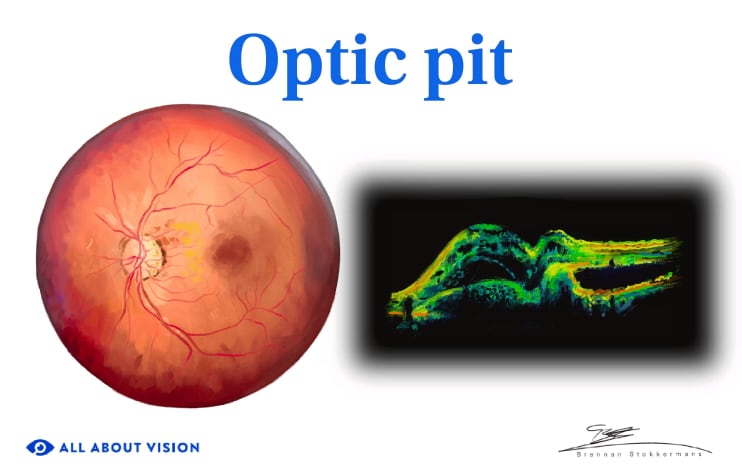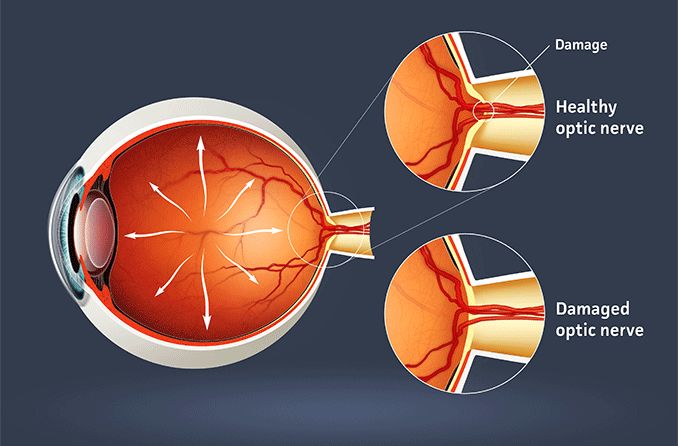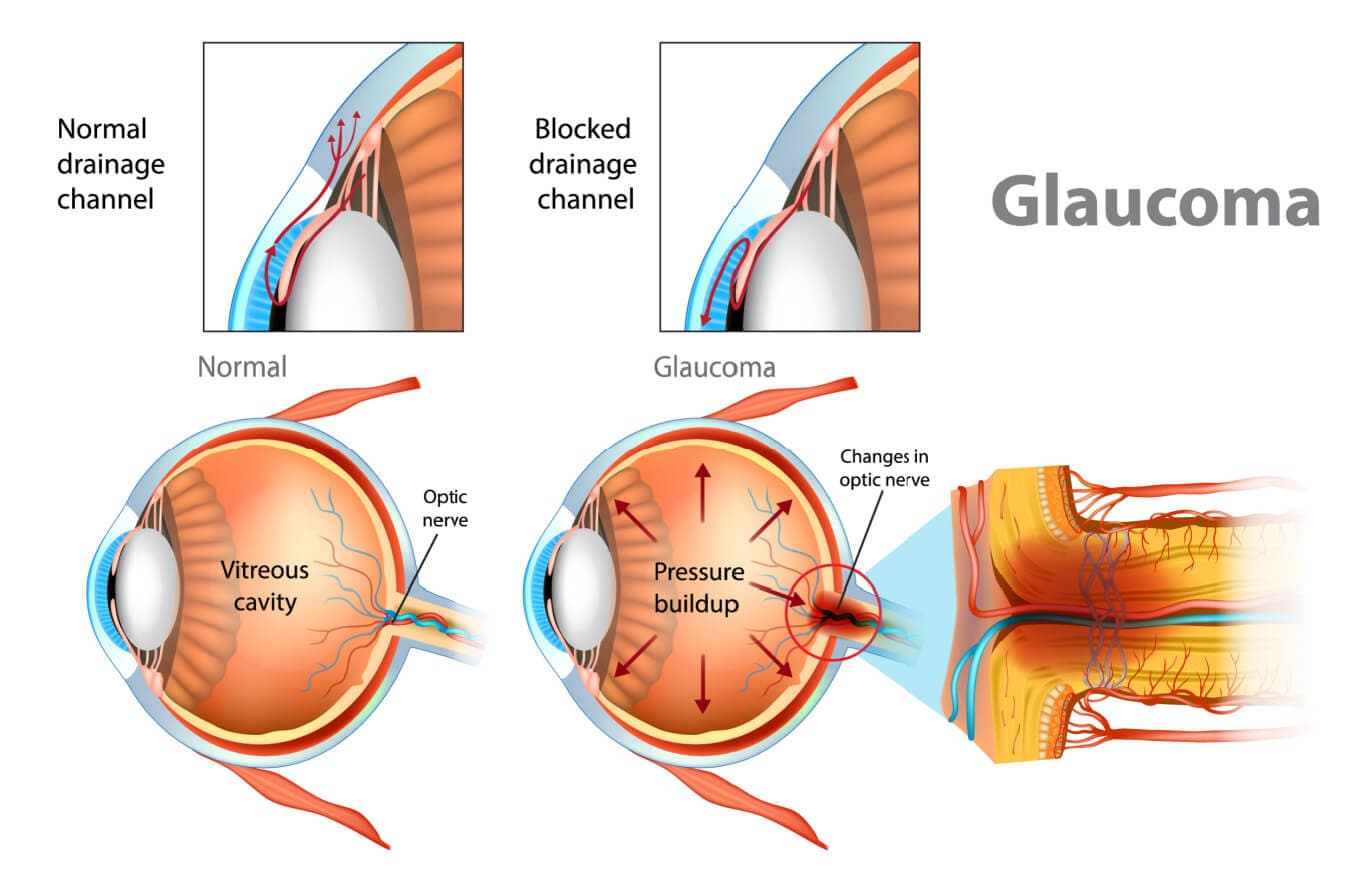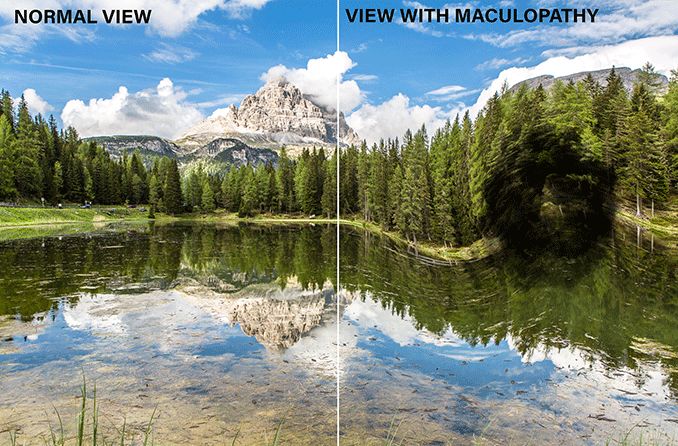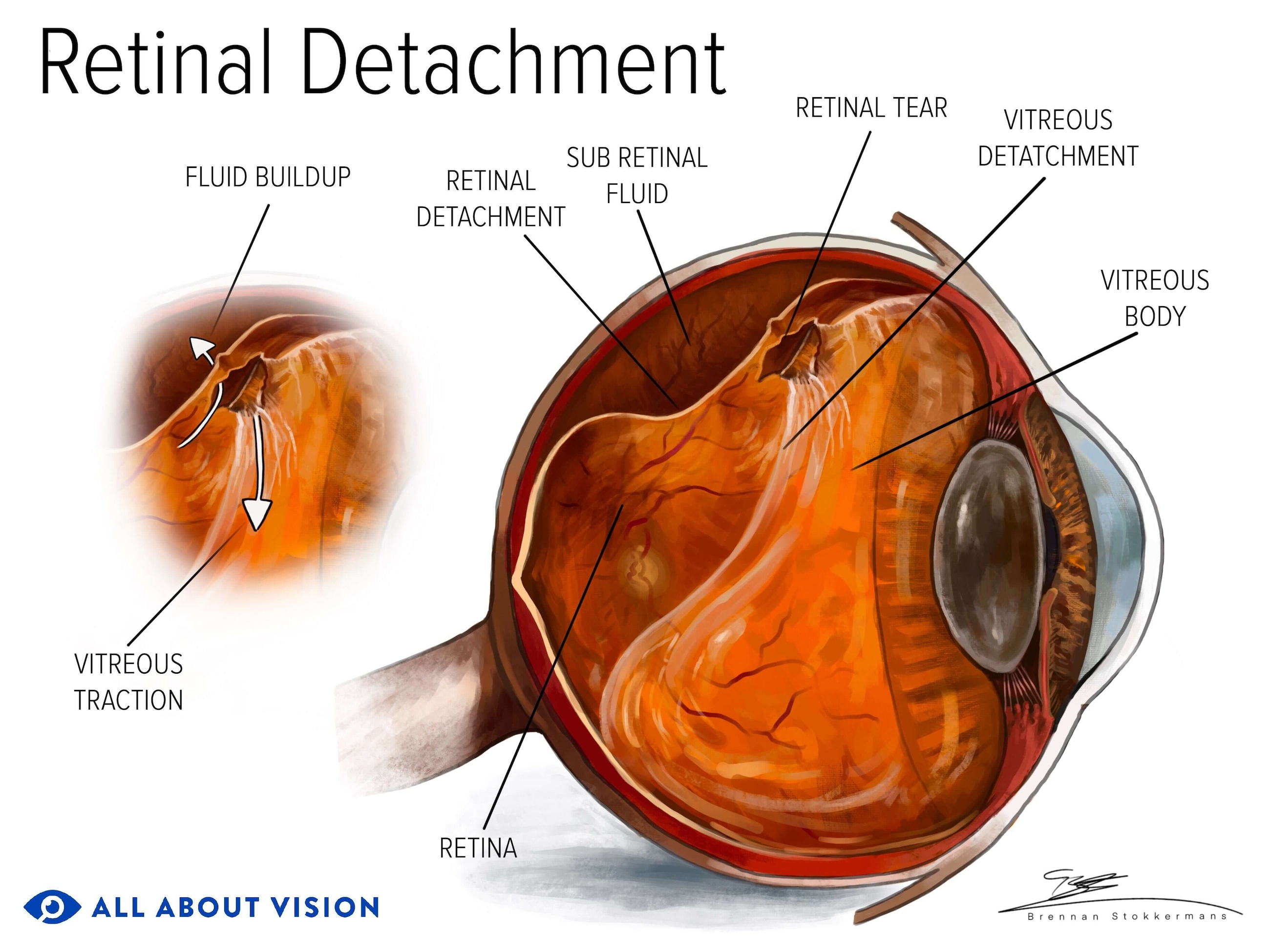What is an optic pit?
An optic pit is a small hole or opening on the optic disc, which joins the eye to the optic nerve (the nerve that connects the eye to the brain). They don’t always cause symptoms or vision impairment, but they can lead to damage over time by causing fluid to accumulate in places it shouldn’t be.
Optic pits (also known as optic nerve pits or optic disc pits) happen in about 1 in every 10,000-11,000 people. An optic pit can be present in both eyes, but it usually only occurs in one. Most optic pits are congenital, meaning they are present at birth. However, some people can develop acquired optic pits following glaucoma (a group of diseases that affect the optic nerve) or myopia (nearsightedness).
Generally, symptoms only happen if the optic pit has progressed to optic disc pit maculopathy. Maculopathy refers to the deterioration of the macula, the center of the retina (a layer of cells at the back of the eye that senses light). Optic disc pit maculopathy can appear at any age. It can sometimes resolve on its own, but this happens in only about a fourth of cases.
Optic disc pit maculopathy develops in about 25%-75% of people with an optic pit. It can lead to serous detachment of the retina or macula, which is when the accumulation of fluid causes the structure to separate from the rest of your eye. Maculopathy can also lead to cystic or degenerative changes in the macular pigment, which protects the retina from too much exposure to light and has antioxidant effects.
Causes
Optic pits are usually congenital. There is no official consensus on what causes a congenital optic pit, but it is believed to occur when a structure called the optic fissure doesn’t close all the way after forming.
However, it is possible to develop one following glaucoma or myopia. It is thought that the damage from these conditions, caused by stretching of the eye structures, can affect the optic disc, eventually resulting in a pit.
Embryogenesis
The optic fissure forms during embryo development and contains an artery that supplies the inner chamber of the eye while it develops. The optic fissure is not meant to be permanent. Normally, it closes on its own by about week seven of embryonic development.
If the optic fissure doesn’t close properly, it leaves a connection between the retina and the subarachnoid space. The arachnoid is the middle layer of the protective membrane over your brain and spinal cord. The subarachnoid space refers to the area between the arachnoid and the innermost layer, the pia mater. It contains a fluid called the cerebrospinal fluid (CSF). An abnormal connection between these areas gives the CSF access to the retinal area from the subarachnoid space.
When the optic fissure doesn’t close, it can also leave behind a coloboma, or a region of the eye with missing tissue. Colobomas can affect the optic nerve and other eye structures, such as the iris (the colored portion of the eye), retina, lens and eyelid.
Fluid accumulation
How fluid builds up underneath an optic pit is not completely understood. Two primary theories are:
- CSF leaks from the subarachnoid space through the optic pit into the macula.
- Fluid accumulates from the vitreous. The vitreous is the fluid in the vitreous cavity, which sits between the lens (at the front of the eye) and the retina.
Increasing amounts of fluid that build up underneath the retina can interfere with normal retinal functioning, leading to permanent damage and possible vision loss.
Optic pit symptoms
In general, an optic pit doesn’t cause symptoms and may only appear if the optic pit has progressed to maculopathy.
Visual field defects
Of the people who do experience symptoms, roughly half start to have vision changes in their 20s or 30s. Deteriorating vision can be caused by damage to the macula, usually from serous fluid. If enough fluid builds up under the retina or serous detachment happens, vision changes can include:
- Blurry vision
- Metamorphopsia (distorted, stretched or wavy vision)
- Micropsia (objects appearing smaller than they really are)
- Scotoma (blind spot)
Optic pits can also displace the fibers of the optic nerve, which can also cause vision changes. These changes are primarily larger blind spots that are arc-shaped, called arcuate scotoma.
Diagnosis
An optic pit is commonly found during an eye exam by an ophthalmologist or optometrist. If your doctor is looking specifically for an optic pit, there are several tests they can use.
Optical coherence tomography (OCT)
Optical coherence tomography is a test that uses light to reconstruct an image of your eye for evaluation. It is especially useful for looking at the back of the eye. OCT is often used to find fluid, a hole or other issues in the retina and macula.
Fundus examination
Fundus photography can be used to find areas of macular or retinal detachment or schisis. This technique involves a special camera that lets the doctor see certain parts of the eye, including the retina and macula. Fundus autofluorescence, which can help determine the presence of certain molecules that indicate retinal deterioration, can also be used.
Fluorescein angiography
Fluorescein angiography uses a special dye (injected into the arm) and camera to allow the doctor to see blood flow in the retina. For the diagnosis of optic nerve pit, it is primarily used to rule out other diseases.
Treatment options
There isn’t any treatment for the actual optic pit. But regular observation allows the fluid buildup to be monitored and any symptoms to be addressed quickly.
Observation
Observation is recommended when maculopathy isn’t present. Some people with an optic pit never show symptoms, or the fluid under the retina may go away on its own.
In other cases, an optic pit may lead to optic disc pit maculopathy. Regular observation increases the chances of maculopathy being caught at an early stage. Once maculopathy is involved, eye surgery may be needed.
Surgical interventions
If an optic pit does lead to maculopathy, there are a number of surgical procedures that can help remove fluid or reattach the retina or macula.
Laser photocoagulation
Laser photocoagulation can be used to form a scar between the retina and the choroid, which is the layer of tissue separating the retina from the sclera (white of the eye). The scar tissue then acts as a barrier, stopping fluid from entering the area underneath the retina.
It’s uncertain how ultimately successful this treatment is, especially if used alone. It can take a long time to show results, and in some cases has not been shown to help recover visual acuity.
Pars plana vitrectomy
The term “vitrectomy” refers to removing the vitreous body. A pars plana vitrectomy removes the vitreous fluid by accessing the eye through a part called the pars plana. Removing the vitreous fluid lessens vitreous traction, which helps the macula or retina reattach. This procedure shows promising results for improving vision.
Pars plana vitrectomy can also be combined with several other procedures to increase the likelihood of a successful outcome. These can include:
Oil or gas tamponade
In a tamponade, a substance, like gas or oil, is injected into the eye. The substance can help displace the vitreous fluid. Some substances, like gas, will dissipate on their own. Others, like oil, will require surgical removal at a later point.
Gas injection into the vitreous can also help seal the optic pit, which helps the macula reattach. If used alone, this treatment can require multiple injections. It has shown good results when used with other treatments, like laser photocoagulation.
Internal limiting membrane peeling or flap
The internal limiting membrane (ILM) is the most central layer of the retina. The ILM helps the retina stay rigid, so removing it (peeling) can make the retina flexible and easier to work with during surgery. Peeling the ILM may also cause the body to release cells that can promote healing, which can help patch up any problematic holes. An ILM flap may also be used — folding it over the optic disc forms a plug, reducing the amount of fluid that gets stuck there.
Glial tissue peeling
Removal of the glial tissue may help relieve any tractional forces caused by the vitreous fluid. Wound healing following removal may also help seal any connection at the optic pit.
Inner retinal fenestrations
Inner retinal fenestration refers to making holes in certain areas of the retina, which can help the fluid flow out and back into the vitreous cavity.
Plugging
An optic pit can also be “plugged” using different materials, such as the ILM or human amniotic membrane.
Macular buckle
A macular buckle involves placing a special implant at the back of the eye that causes the macula to “buckle.” The compression helps the macula reattach. Although it shows success as a treatment, this procedure is not often favored because it is very specialized and technical.
Other treatments
Optic disc pit maculopathy is usually managed with a surgical procedure (or a combination of procedures). In some cases, a carbonic anhydrase inhibitor drug may also be taken before and/or after surgery.
These drugs can reduce liquid in the eye by blocking an enzyme called carbonic anhydrase. They are sometimes used to treat glaucoma. Acetazolamide, in particular, has been studied for the treatment of optic disc pit maculopathy.
Acetazolamide
Acetazolamide can decrease the amount of CSF produced through its anhydrase-blocking effects. As such, it can be useful as a treatment in cases where CSF leaks through the optic nerve pit. This treatment has shown good results as an oral medication taken before or after surgery. However, there isn’t a large amount of evidence for its use in optic disc pit maculopathy yet.
Recent research and advances in treatment
How optic disc pit maculopathy progresses and how best to treat it are still being studied. As our understanding of optic disc pit maculopathy grows, new treatments are becoming available. One cutting-edge treatment is the use of a corneal stromal lenticule (CSL) as a material to seal the optic pit.
Corneal stromal lenticule
The term CSL refers to a “lenticule” (a small segment of the cornea, shaped like a disc) that is removed during small incision lenticule extraction, or SMILE surgery. In this surgery, the lenticule is removed from the cornea to help change its shape so your eye is able to focus light better.
CSL material left over and preserved from SMILE surgery has been used for the treatment of other eye conditions. Recently, it was used for optic disc pit maculopathy as a way to seal the space between the subarachnoid and subretinal areas.
CSL material has strong biocompatibility and does not degrade over time, so it has an increased possibility of providing an effective seal. However, this is a new treatment direction that will need more research before becoming a standard.
Prognosis and management
The prognosis for an optic pit is generally good, especially if it is isolated. For the most part, visual symptoms happen only when it progresses to maculopathy.
Visual outcomes
Some cases of optic disc pit maculopathy will resolve on their own. Sometimes, this means that visual acuity will return to normal or at least improve.
If maculopathy does occur, visual acuity will usually get worse within a period of about six months. Vision typically drops to somewhere around 20/70 but can get as low as 20/200.
If vision is severely impaired, then surgical interventions have a good success rate in restoring function. Depending on the individual patient, a combination of surgeries may be performed.
Regular monitoring
Observation alone is usually recommended for patients who have good vision and minimal (if any) symptoms. If symptoms do start to get worse, observation may still be recommended on the chance that the condition resolves on its own. In either case, regular monitoring and follow-up appointments with your eye doctor are necessary to look for fluid buildup and to address symptoms, like blurry vision.
When to see an eye doctor
It is possible to have an optic pit and never experience any symptoms. However, because maculopathy can cause serious visual impairment, it’s important to see an eye doctor regularly to track whether that damage is happening.
It’s also recommended to monitor your vision at home. An easy way to do this is with the Amsler grid, a grid of straight lines with a dot in the center. Focusing on the grid and noting whether the grid lines stay straight can indicate maculopathy. If there is damage to the macula, the lines may appear wavy, dark or blank.
Most optic pits are diagnosed during a routine eye exam, so your doctor may notice one incidentally. If you are experiencing vision problems, your doctor can perform a series of diagnostic tests to help determine whether an optic nerve pit is present.

